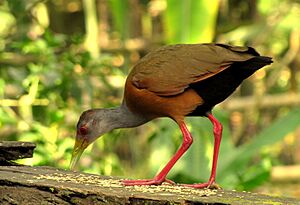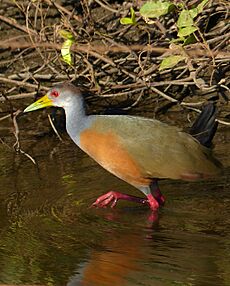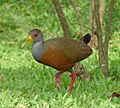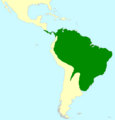Grey-cowled wood rail facts for kids
Quick facts for kids Grey-cowled wood rail |
|
|---|---|
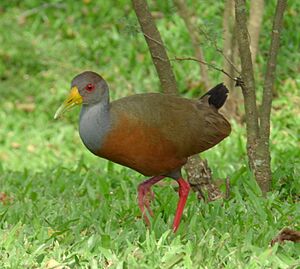 |
|
| Grey-cowled wood rail | |
| Conservation status | |
| Scientific classification | |
| Genus: |
Aramides
|
| Species: |
cajaneus
|
| Subspecies | |
|
See text |
|
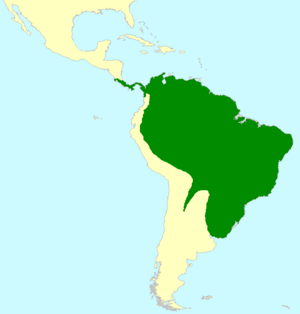 |
|
| Synonyms | |
|
List
Aramides cajanea
Aramides plumbeicollis Aramides chiricote Rallus chiricote |
|
The grey-cowled wood rail or grey-necked wood rail (Aramides cajaneus) is a type of bird in the Rallidae family, which includes rails and crakes. This bird mainly lives in the forests, mangrove swamps, and regular swamps of Central and South America.
There are two main types, or subspecies, of this bird. One is called A. c. avicenniae, and it lives in southeastern Brazil. The other, called the nominate subspecies, lives in most other parts of the bird's range. You can usually find these birds from sea level up to about 2,000 meters (6,600 feet) high. Sometimes, they are even found higher up. This bird is not considered endangered by the International Union for Conservation of Nature (IUCN). This is because there are many of them, and they live across a very large area. In some places, people occasionally hunt them for food.
Contents
About the Grey-Cowled Wood Rail
This bird is quite large for a wood rail. It has a grey head and neck. The main type of this bird has a brown patch on the back of its head. Its upper body feathers are olive-green to dark brown. The chest and sides are a reddish-brown color. The belly, rump, and tail are black. Its legs are bright coral-red, and its beak is a bright greenish-yellow. The eyes are red.
Both male and female grey-cowled wood rails look very similar. Young birds, called juveniles, look a bit duller than adults. Baby chicks are black and fluffy, with a brown head and a black beak.
The subspecies avicenniae is a bit different. It is smaller and does not have the brown patch on the back of its neck. Its lower back is slightly olive, and its belly feathers are paler.
What Does It Sound Like?
The grey-cowled wood rail makes a loud, repeated cackling sound. You can hear it most often at dawn and dusk. Their calls often sound like pop-tiyi pop-tiyi co-co-co-co-co or chitico chitico cao-cao-cao. These birds often sing these calls together in a group or as a pair. When they are alarmed, they make a harsh, loud cackle or a clucking shriek.
Where Does It Live?
The grey-cowled wood rail lives in many countries. These include Argentina, Bolivia, Brazil, Colombia, Costa Rica, Ecuador, French Guiana, Guyana, Panama, Paraguay, Peru, Suriname, Trinidad and Tobago, Uruguay, and Venezuela.
The main subspecies lives east of the Andes Mountains. It is not found in southeastern Brazil. The avicenniae subspecies lives along the coast of southeastern Brazil, especially near São Paulo.
This bird's natural homes are moist lowland forests in warm areas. They also live in mangrove forests and swamps. The avicenniae subspecies mostly lives in mangrove forests. These birds can be found from sea level up to about 2,000 meters (6,600 feet) high. Sometimes, they are seen even higher, up to 2,300 meters (7,500 feet) in Colombia.
Behaviour and Ecology
These birds can perch on shrubs and even in trees. This is common for forest rails. The grey-cowled wood rail rarely flies. If it is scared, it will usually fly to a branch close to the ground. When people watch it, it is usually very careful and shy.
Reproduction and Life Cycle
The grey-cowled wood rail builds its nests in trees and bushes. Nests are usually about 1 to 3 meters (3.3 to 9.8 feet) off the ground. They are built on flat branches or in thick bushes. The nests are lined with twigs and leaves.
These birds are monogamous, meaning they stay with one partner for a long time. Pairs of grey-necked wood rails stay together all year. Their breeding season usually runs from March to August. However, this can change depending on where they live. In Costa Rica, it can last until September. In Mexico, it can start as early as January.
A female grey-cowled wood rail usually lays three to seven eggs. Five eggs are most common. The eggs are whitish with brown spots and are slightly shiny. Both parents take turns sitting on the eggs to keep them warm. Each parent incubates for six to eight hours at a time. The eggs hatch after about 20 days.
The chicks are precocial, which means they can move around soon after hatching. The parents care for them for one or two days before they leave the nest. Sometimes, chicks will use the nest until they are 40 days old.
What Does It Eat?
This bird feeds at night. It eats many different small animals without backbones, like invertebrates. It also eats small animals with backbones, like vertebrates. When it is in mangroves, it often eats crabs.
Other foods include molluscs like snails, and arthropods. They also eat frogs, seeds, grains, leaves, and berries. They enjoy palm fruits and sometimes even small water snakes. Maize (corn), rice, and bananas are also foods they can eat. Interestingly, they are also known to eat the droppings of giant otters at their latrines.
When eating snails, this rail will hit the shells to get the snail out. For berries, it will jump high to break off bunches of fruit. Then, it will pick off the berries one by one to eat them. It uses its beak to poke around and move leaves or other things out of the way. It is usually shy and secretive.
Status and Human Interaction
The IUCN considers this rail a least-concern species. This means it is not currently at risk of becoming endangered. This is because its population is stable and large, with an estimated five million to 50 million individuals. The grey-cowled wood rail also lives across a huge area, covering about 21.4 million square kilometers (8.3 million square miles). It is common in its range. However, its habitat can be harmed by human activities.
In some parts of northeast Brazil, people sometimes hunt the grey-cowled wood rail for food. They often use baited fish hooks placed near water where the birds look for food. In Panama, people also keep this bird for food. Even though it is usually careful, it can let humans get as close as 10 meters (33 feet) before it hides in the bushes.
Images for kids




